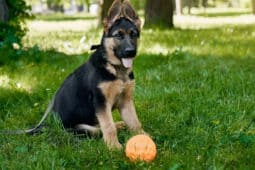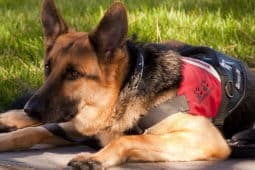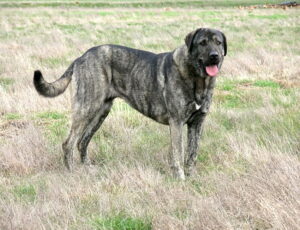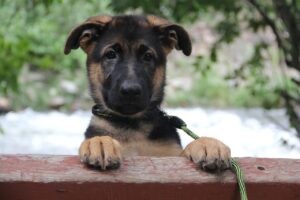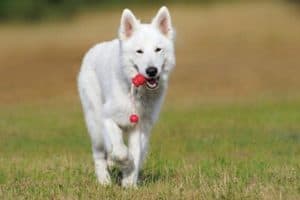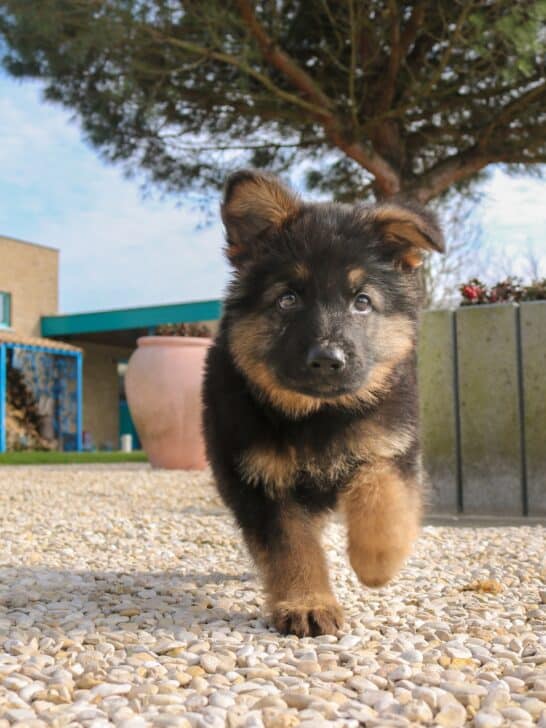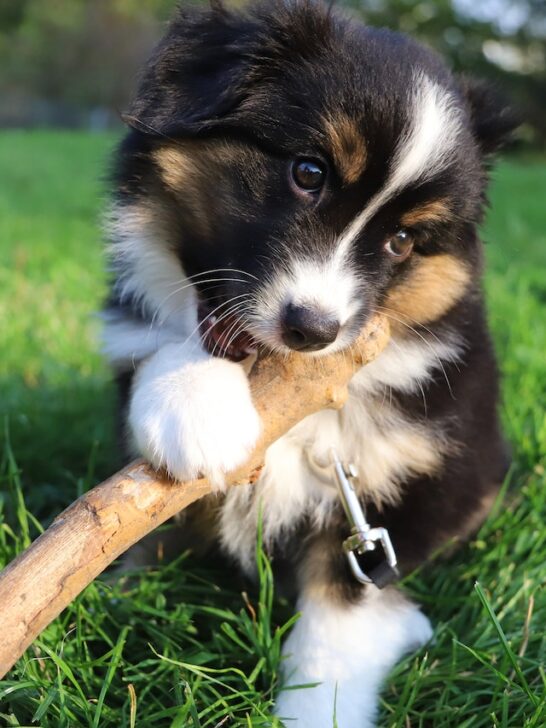At What Age Will Your German Shepherd Dog First Get Aggressive?
Do you ever wonder how a dog figures out what her purpose will be? German Shepherds always seem so driven and competent in whatever they do.
Everyone knows to respect the business end of an Alsatian. When does that happen?
Specifically, at what age does a German Shepherd become aggressive?
There are several ways to look at aggression, and it shows up in Shepherds at various stages of their life. Dominance can appear as early as six or eight weeks of age.
However, personality traits establish themselves around puberty. Dogs that are not aggressive puppies may start to exhibit protectiveness with adolescence.
Other Shepherds may be late bloomers and not demonstrate aggression until they are two years old. Still, others receive formal training and learn to be aggressive at designated times.
We will talk about when Shepherds naturally develop aggression and discuss outside factors that may influence behavior.
What can you tell about a six-week-old pup?
Have you ever purchased a puppy where a breeder picked from the litter for you?
Perhaps he or she asked you a few questions about your household and family life and told you she had the perfect dog. How would they know the ideal dog for you?
You can perform certain personality tests on very young puppies and it gives you a somewhat loose indicator of future tendencies.
You can spot aggression as early as six to eight weeks in some puppies. Several breeders perform personality tests to try to match puppies with the most compatible homes.
Even if a puppy does not exhibit aggressiveness, a personality test can tell you if he might develop it later. You may wonder how this is relevant to German Shepherds who you expect to be aggressive.
A personality assessment may tell you something about the type of behavior you can expect.
Most tests specifically differentiate alpha and submissive traits. If you are an extremely active or avid hiker, you may want an A-type of dog.
Dominance aggression might be perfectly acceptable for the military or extremely experienced and assertive owners.
However, you want a more laid back pet if your goal is to add a dog to a family complete with children and other pets. Neither dominance nor timidity is particularly suited in such an atmosphere.
Even if a breeder does not conduct assessments, you can bring your criteria and spend some time with the litter.
According to Raisingrascal.com, working dogs require additional more in-depth testing.
However, the following simple tests will give you an idea about the development of aggression in your potential pet German Shepherd.
- Cradle – Cradling a puppy in your arms is an alternative to holding her on her back. A dominant dog with aggressive tendencies will not tolerate it and a timid dog will attempt to escape.
- Grab and hold a rear leg
- Tuck and pat – There are two variations of the tucking exercise that tests dominance levels in a puppy. In the first option, you hold the pup with your legs and stroke firmly while talking in an encouraging tone. You can also place the puppy in your lap while petting him. The key is firm pats.
- Bend – Standing over a puppy and bending down to pet him from up high is a great challenge to a dog’s social psyche that should prove quite informative about a potential pet’s personality.
- Uplift – You lift the puppy a few inches off the ground supporting him by the abdomen with legs hanging.
- Call – You can judge how a puppy reacts when you try to gain her attention and entice her to approach you.
Testing allows you to classify a puppy’s temperaments in various ways. Some schools have three personality classifications and others have four.
There are many subtle differences in disposition. Simple temperament tests use only a few categories but provide enough data about probable aggression to decide on a pet.
A widespread classification system is dominant or active and submissive or timid at the extremes with independent and docile in between.
Dominant or A-types will run to you when called and protest any attempts to hold them or approach them from above.
Submissive or passive puppies squirm and try to get away from uncomfortable situations and need reassurance and coaxing to come when called.
Is there an ideal age to check a puppy’s temperament? Many of the simple temperament tests are most effective when a puppy is seven or eight weeks old.
You can positively affect temperament and modify aggression with training and socialization.
Experts say socialization is most important between 8 and 20 weeks old. TrainYourGsd.com classifies German Shepherds as a sensitive breed that requires socialization even beyond the age of three years.
What happens with the teenage years?
German Shepherds enter adolescence around five or six months of age. Their teenage months are extensive, lasting until your dog is two years old.
Many dogs do not come into their full personality until they end puberty and develop aggression at this age.
However, German Shepherds commonly receive training early and develop aggression concurrently. Also, intact dogs often develop aggression more quickly with hormones related to sexual maturation.
Like human teenagers, adolescent German Shepherds are impressionable and rebellious at the same time.
The ages between six months and a year can be almost as critical for a GSD’s socialization as the early puppy weeks.
According to TrainYourGsd.com, German Shepherds begin testing the boundaries of authority at 10 to 12 months old.
In a year, a GSD has almost reached his final height and without sufficient exercise and guidance will challenge you and any past training.
He may also begin to demonstrate dominance towards other dogs and territorial aggression. Your first sign of your dog becoming aggressive may be barking when the doorbell rings.
Which types of aggression can affect German Shepherds?
The GSD, like all dog breeds, have complex emotional relationships with their environment and the people in their lives.
A certain level of aggression is normal in German Shepherds because of their breeding and development for security, the military, and law enforcement.
However, a GSD can become inappropriately aggressive with poor breeding, inadequate socialization, and mistreatment.
Fearful Aggression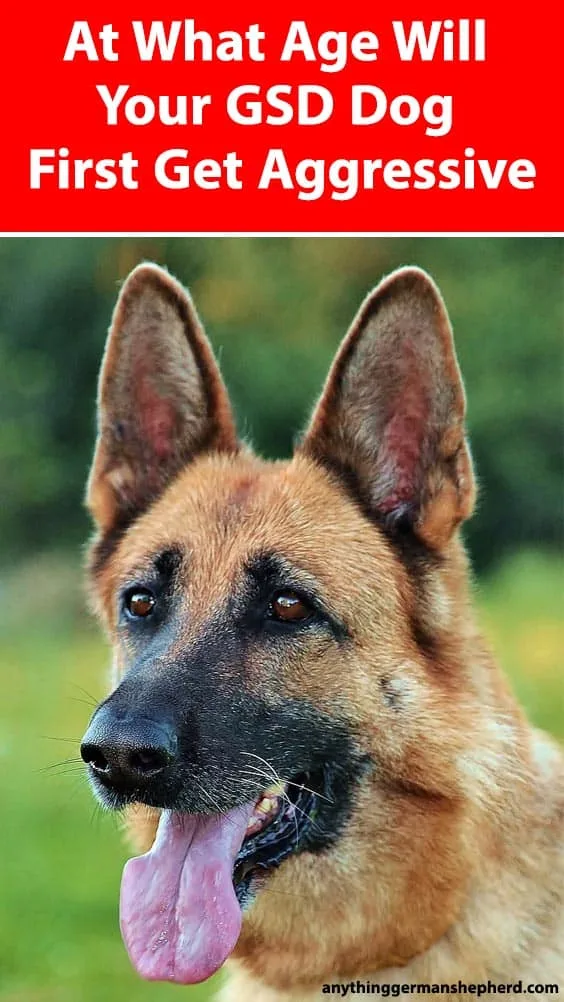
Fearful dogs can be just as dangerous as vicious dogs. Timidity causes German Shepherds to become unpredictable and defensive.
Fearful Shepherds often feel backed into a corner and will attack if you continue to pressure them in an uncomfortable situation.
Anxiety-ridden bites can be severe because the dog is motivated with the help of adrenaline.
You can differentiate these fearful shepherds from vicious dogs based only on the tucked tail and hindquarters. Here is a YouTube video about the fear of an aggressive German Shepherd.
Fearfulness in German Shepherds is a serious problem in a breed celebrated for its courage and boldness. Fear can come from several sources for a Shepherd.
Certain family lines of German Shepherds exhibit shyness and fear-biting. Some working line breeders and handlers on the police force blame certain show lines.
Nevertheless, any breeding without regard for temperament can produce Shepherds who deviate from the finer qualities of the breed standard.
German Shepherds can also develop a fear of aggression from a traumatic experience. Poor training methods such as beating, whipping, or yelling can scar a Shepherd for life.
But during her adolescent years, bumbling a nail trim or rough handling your Shepherd during a grooming session can have a lasting negative impression.
Dominance
Although commonly misdiagnosed, according to UC Davis, dominance aggression is a feature of some German Shepherds.
A truly dominant dog is dangerous, especially for an inexperienced owner. She will not tolerate guidance or discipline without threatening serious harm.
As long as you go along with what your dog wants, she is a happy-go-lucky companion.
Dogs develop dominance aggression for many reasons.
Some breeds, like the GSD, are predisposed to assume the Alpha role and you can often spot these dogs with the puppy temperament tests mentioned earlier.
They can be excellent pets or indispensable working dogs with the right experience level and self-assuredness.
Some dogs develop dominance in a household without structure or boundaries.
Spoiled Shepherds who become used to getting everything they want can protest aggressively against someone suddenly trying to establish authority.
Many people behave in ways that invite their GSD to take leadership without even realizing it.
Having your Maltese sit on your lap, sleep in your bed, or fight you for the pillow is much different than engaging in such activities with a German Shepherd.
Several signs indicate you may have a problem with your dog.
- Possessiveness over anything such as food, toys, the bed, you, and other pets.
- Shows possessiveness by growling, snarling, and snapping. A dominant dog may also bite with little provocation.
- Ignores your commands or will not allow you to leash him.
- Charges or growls at people, or becomes aggressive when you or someone else tries to touch him or move him off furniture.
- Jumping on, leaning against, or otherwise imposing herself on your personal space.
Territorial and Protective
Territorial aggression is extremely useful for guard dogs. However, without proper training, your German Shepherd guard dog can become dangerous because he may not learn discrimination.
As Pethelpful points out, territorial aggression can be the basis of potential lawsuits.
Territorial aggression usually extends to property and family members with the German Shepherd.
Protective aggression was instilled in ancestral German Shepherds to keep the livestock herd safe from hazards and predators.
Reactionary
A dog can become aggressive in reaction to a stimulus. Stimuli can be a pain, illness such as brain disease, or overexcitement like the sight of another dog.
Trained Attack
While Shutzhund may begin at 8 to 11 weeks of age, trainers typically avoid drive work during a pup’s teething. Drive work involves motivational tools like toys.
You reward your dog with a favorite game or drive award as the ultimate motivation at the end of a session.
Defense work and bite sleeves, according to Leerburg.com, have a huge mental component and should not start before 11 months of age.
Police training, on the other hand, begins shortly after two months old. Of course, much early police work involves socialization.
Aggression Between Dogs
German Shepherds can have a high prey drive, chasing small dogs, cats, and squirrels, sometimes to kill them. Often they are aggressive toward other dogs, especially against the same gender.
Although German Shepherds commonly show aggression against dogs who trespass on their yards or threaten their families, their hostility may extend to household pets.
Summing up at what age German Shepherds become aggressive
There is no magic age when a Shepherd becomes aggressive. Different motivations for a dog’s aggression effect when it appears as does Shepherd’s stage of development.
Both dominance and fear aggression seems to be primal, and German Shepherds can express them as very young puppies.
Fear aggression, however, is not always genetic and can appear after a traumatic event.
Territorial aggression requires a certain degree of self-assurance and thus shows up during or after adolescence. Aggression on command involves a combination of training and the dog’s self-confidence.
Often, Shepherds gain validation through proper training and therefore may gain attack aggression as early as five to six months old.
Aggression against other dogs a Shepherd considers rivals and not prey correlates with sexual maturity between six and eight months old.















